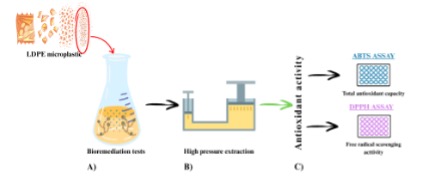From pollutant to product: the bioactive potential of fungal biomass obtained through bioremediation processes
DOI:
https://doi.org/10.48797/sl.2025.362Keywords:
PosterAbstract
Background: Microplastics are widespread environmental pollutants, and recent attention has turned to the potential of bio-based approaches for their removal and mitigation in various environmental settings. Among these biotechnological methods, fungi have emerged as key players due to their resilience, ease of use, and minimal health risks. While the effectiveness of fungal bioremediation in removing microplastics has been demonstrated, the fate of the fungal biomass after treatment remains largely unexplored [1–3]. Objective: This study aims to investigate the antioxidant activity of extracts derived from Penicillium brevicompactum, used in the biological removal of low-density polyethylene (LDPE) microplastics. Methods: Bioremediation tests were conducted to assess the ability of Penicillium brevicompactum to remove LDPE microplastics. The resulting fungal biomass underwent high-pressure extraction, and the obtained extracts were then tested for antioxidant activity. For that, two different assays were used: free radical scavenging activity (DDPH assay) and total antioxidant capacity (ABTS assay). Results: Bioremediation assays demonstrated that Penicillium brevicompactum was able to remove approximately 40% of the LDPE microplastics over a 21-day period. The extracted fungal biomass showed antioxidant activity, suggesting that the extracts could have potential applications in various industries. Conclusions: The study highlights the potential of fungal biomass as a valuable resource, with possible applications in reducing environmental waste and producing bioactive compounds for industries such as cosmetics, pharmaceuticals, and food additives. Although the bioactivity of the extracts was limited and may not immediately be amenable to commercial applications, it highlights the potential applications of such bioremediation strategies within a context of circular economy. However, there is the need for further research to fully realize the benefits of this innovative approach.

Figure 1. Schematic representation of the methodology: a) bioremediation assay of LDPE microplastics by Penicillium brevicompactum; b) fungal biomass obtained underwent high-pressure extraction; c) resulting extracts tested for antioxidant activity using two assays: DPPH and ABTS.
References
1. Ferreira-Filipe, D.A. et al. Biodegradation of E-Waste Microplastics by Penicillium Brevicompactum. Sci Total Environ 2024, 935, 173334, doi:10.1016/J.SCITOTENV.2024.173334.
2. Paço, A. et al. Biodegradation of Polyethylene Microplastics by the Marine Fungus Zalerion Maritimum. Sci Total Environ 2017, 586, 10–15, doi:10.1016/J.SCITOTENV.2017.02.017.
3. Thacharodi, A. et al. Microplastics in the Environment: A Critical Overview on Its Fate, Toxicity, Implications, Management, and Bioremediation Strategies. J Environ Manage 2024, 349, 119433, doi:10.1016/J.JENVMAN.2023.119433.
Downloads
Published
How to Cite
Issue
Section
License
Copyright (c) 2025 Ana Sousa, Virgínia Gonçalves, João Costa, José Andrade

This work is licensed under a Creative Commons Attribution 4.0 International License.
In Scientific Letters, articles are published under a CC-BY license (Creative Commons Attribution 4.0 International License), the most open license available. The users can share (copy and redistribute the material in any medium or format) and adapt (remix, transform, and build upon the material for any purpose, even commercially), as long as they give appropriate credit, provide a link to the license, and indicate if changes were made (read the full text of the license terms and conditions of use).
The author is the owner of the copyright.









